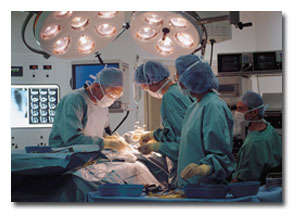P
rotection from nasty viruses and other infectious microorganisms is a paramount concern
within the medical sector. Antimicrobial and sterilization treatments do their part to eliminate
surface contaminants, but there are times when a physical barrier is needed to prevent penetration
of blood- or other fluid-borne pathogens — for example, in a surgical or emergency response
environment where the practitioner or responder may come in direct contact with such pathogens, or
to protect a wound from outside infection while it heals.

Waterproof, breathable membranes bonded to fabrics used for surgical gowns and masks, wound
dressing and cast coverings, and other protective clothing can provide such protection. The
membranes may be monolithic or microporous, or a bicomponent film that takes advantage of the
particular attributes of each.
While monolithic and microporous films may provide similar protective and comfort
properties, they differ in their physical structures and ways of functioning.
Microporous films have microscopic pores through which vapor such as perspiration may be
transmitted via gaseous diffusion or convection. Depending on pore size, liquid molecules are too
large to pass through. However, liquids under pressure may be able to penetrate these films; and
contamination by substances such as body oils, pollutants, cleaning substances and others also may
adversely affect the membrane’s water repellency.
Monolithic films contain no pores that might allow liquid penetration, and moisture vapor is
transmitted via a solid-state diffusion process. However, the films will swell and stretch when
wet, which can cause cracking and weakening over time if the film is made from a polymer that does
not offer good stretch and recovery.
Monolithic films made with
thermoplastic polyurethane (TPU), copolyester or ether-amide polymers are said to offer good to
excellent stretch and recovery, reducing the likelihood of cracking and increasing the film’s
durability and abrasion resistance, according to Paul Darby, president, Omniflex Inc. — the
Greenfield, Mass.-based maker of Omniflex Transport®, a line of extruded monolithic films made with
these materials.
Darby said extruded films are more
supple than liquid films, which are coated onto a fabric or a nonwoven, stiffening it in the
process. He also noted there are advantages to using extruded films such as Transport that are made
without the use of processing aids that can reduce the fabric’s breathability and affect the
strength of the bond between film and fabric.
Darby pointed out that TPU, copolyester and ether-amide films are quiet and comfortable and
offer a soft hand — with TPU offering the highest degree not only of these qualities, but also of
stretch and recovery and breathability. Because such films also are chemical- and
temperature-resistant, they are more cost-effective to use than bicomponent films that include
polytetrafluoroethylene to provide those qualities, and yield garments that are lighter-weight and
more compressible than those made with bicomponent films.
November/December 2005




